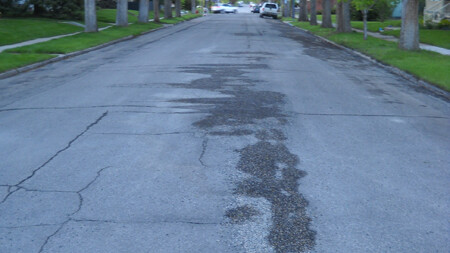Bozeman’s Pothole Problem
The pothole hotline number is 582-3208

The potholes that inhabit the streets of the Greater Bozeman area seem to be a never-ending source of irritation, whether a traveler is on foot, on a bicycle, or in a vehicle. Some of these suckers will swallow a small car. And the same potholes seem to reappear after repair like clockwork.
The folks traversing Bozeman’s streets are not the only ones that are probably irritated with the city’s pothole problem. There are eleven full-time road maintenance crew members working on the over-200 miles of city streets which require care that not only includes pothole repair, but leaf removal, street sweeping, and snowplowing. But it’s the potholes that provide most of the headaches.
Potholes are common to areas of the country that generally have several freezing-thawing conditions during the winter months. A pothole starts as a small failure in the road surface where water has seeped through cracks and into the road base. As the water freezes it expands, and when it thaws a void is left under the asphalt. As vehicles are driven over the voided area the asphalt fails, causing a pothole to form.
If a pothole does form, the crews will use two different types of material to fill the hole, depending on the time of year. The preferred process for warm weather months is to use hot mix. Hot mix is asphalt that is heated to about 300 degrees, and when cooled it hardens to match the road. Asphalt companies do not start making hot mix until the end of April or early May, so during the winter months the crews use cold mix. Cold mix is not heated before application to the extent that hot mix is, and, as a result, it will not harden like hot mix. A pothole repaired with cold mix is likely to reappear sooner.
When there are several potholes forming close together on one stretch of the street the crews will use a process called blade patching. A layer of hot emollient is first put on the street, and then hot mix is applied, which is meant to seal and smooth the road. But if the underlaying infrastructure is outdated, those potholes will most likely reappear unless the road is completely and properly repaired. Case in point South Eighth Street in Bozeman, which certainly is smoother than it was before the road was razed and rebuilt.
Much of the problem locally stems from the fact that older parts of Bozeman, such as the Northside, the University District, and the downtown area, have new streets which are simply built on top of old ones. Many dating from the 19th Century--in fact, on South Grand Avenue, the street was actually built on top of a section of the old Bozeman streetcar system some 80 years ago, and the railroad ties still lie beneath South Grand. Constructing a street on top of those railroad ties may have been the easiest solution back then, but it has certainly led to problems. Though South Grand is being repaired right now, it is almost certain that those potholes will once again rear their ugly heads. And from personal experience, I can tell you, that South Grand stretch of street can be chock-full of potholes.
Last November, Bozeman’s Public Works Director, Craig Woolard, told the city commission that Bozeman needs to double its street maintenance spending to $2 million a year in order to keep up with proactive maintenance. Also, according to Woolard, $60 million in spending will eventually be necessary to complete construction of Bozeman’s street networks to current city limits. Because some street projects in town were funded in part by developers building on properties bordering the city limits, many of the streets in newer parts of the city are somewhat “interesting,” with missing sections of street, overwhelmed intersections and stretches of street without sidewalks and bike lanes.
“We spent 50 years not fixing the roads,” Bozeman Mayor Jeff Krauss said in May. “And that’s caught up with us.” The mayor also said that Montana legislators should have acted to allow Bozeman and other Montana cities to seek voter approval for a 2-cent-a gallon local option gas tax. Krauss said that such a gas tax would help to extend the burden of paying for road maintenance to travelers and tourists, instead of placing the load squarely upon the property owners. Legislators failed to pass such legislation in Montana this time around.
“If that had passed we wouldn’t be talking about [additional road maintenance] taxes,” Krauss said. Increased taxes or not, there is a lot that the residents of Bozeman can do to help the city stay on top of the pothole problem. In fact, the city relies upon its citizens to help keep them informed about the potholes in their neighborhoods.
Bozeman maintains a “pothole hotline” that helps its “pothole patrol” stay on top of the problem as best they can. The city does not have enough street maintenance personnel to dedicate a full-time team to patrol the streets of Bozeman looking for potholes, so city road maintenance crews really need the public to let them know about potholes. The pothole hotline number is 582-3208. Crews try to make the repairs within one week of receiving the report.
So if those potholes in town are getting you down, be sure and give the pothole hotline a call. Potholes will always be a part of life in this part of the country, but a proactive public will help Bozeman keep its streets a bit less bumpy.
